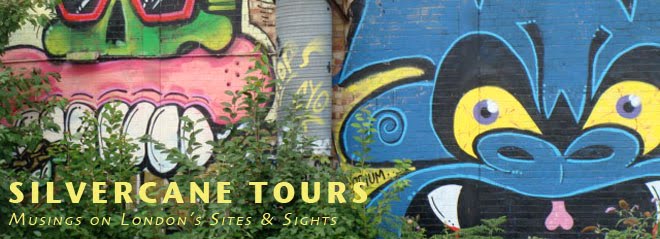 |
| The inventor and his baby |
Hiram S. Maxim arrived in Britain from Maine in the 1880s to run the London office of the US Electric Lighting Company. He eventually became a naturalized British citizen, being knighted by his chum King Edward VII. He was an inveterate inventor – claiming responsibility for the light-bulb – but also amusement rides, hair curlers and even a mousetrap. He remembered as a child being knocked over by the recoil of a rifle. Later in life he encountered an old friend in Vienna who advised him if he really wanted to make big money he should invent something that enabled Europeans to cut each other’s throats with greater facility. His Maxim gun, invented in a workshop in Hatton Garden, was the first rapid fire weapon to operate on the energy of its own recoil. Rapid fire weapons had hitherto used a crank system. Maxim also worked on his gun in the garden of his home in West Norwood, South London, where he would thoughtfully run newspaper advertisements warning his neighbours whenever he intended to trial the weapon. He went into business with Edward Vickers a Sheffield steel magnate and his weapon became the basis for the successful armaments company Vickers Limited.
In the 1890s the Maxim gun was used to lethal effectiveness by the British Army in numerable colonial wars where native forces were encouraged to mount conventional mass attacks to be knocked down in their thousands by Hiram’s nifty invention, memorably at the Battle of Omdurman in 1898 when Kitchener conquered the Sudan. As the poet Hilaire Belloc observed, ‘Whatever happens, we have got/ The Maxim gun, and they have not. ‘
 |
| Hiram at rest in West Norwood Cemetery |
In the 1890s the Maxim gun was used to lethal effectiveness by the British Army in numerable colonial wars where native forces were encouraged to mount conventional mass attacks to be knocked down in their thousands by Hiram’s nifty invention, memorably at the Battle of Omdurman in 1898 when Kitchener conquered the Sudan. As the poet Hilaire Belloc observed, ‘Whatever happens, we have got/ The Maxim gun, and they have not. ‘
Other European powers were attracted to the weapon and it eventually in various adaptions – the pom-pom gun and the Vickers machine gun – was deployed by the imperial powers against each other on the battlefields of WWI.
The Machine Gun Corps memorial at Hyde Park Corner, features two actual Vickers/Maxim guns, bronzed.
The Machine Gun Corps memorial at Hyde Park Corner, features two actual Vickers/Maxim guns, bronzed.





